
.A. C. FROST.

.A. C. FROST.
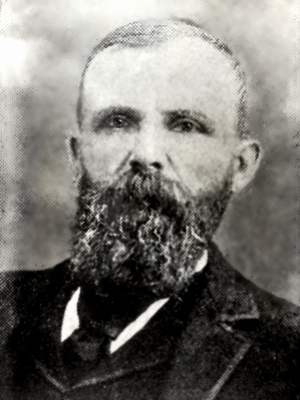
1843 - 1924 Photograph taken in 1895 when he was a member of the Wisconsin legislature. courtesy of Broward County Historical Commission Eby Collection - Florida |
In Denmark
It is likely that Anders Christian Jensen Frost was born near Balum and Tisted, Denmark, from the brief description of his early years which he wrote in the 1920's. The two small villages are only 3 miles apart. In this biographical sketch, which is the only one found that refers to his early life in Denmark, A. C. Frost stated that he was born September 30, 1847. At an early age he was hired to carry the royal mail between Aalborg and Balum, a distance of approximately 10 miles. Aalborg, a large city in the northern tip of Denmark, was the mail postal station for that region of the country and it is likely that A.C. hiked the round trip weekly to bring in the mail. Balum was a small village amid several other small communities, to the south and slightly east of Aalborg. This was the beginning of a nearly life-long connection to mail service in two continents.
A. C. Frost also wrote that for a period of seven years he held the position of chief clerk and bookkeeper in the store owned by Jeppe Neilson in Tustrip, near Skjorping Station. He left Denmark for North America in 1873 at the age of 25 years, based on his statement that his employment at the store began at age 17. He was skilled in bookkeeping and business management at a young age, and he relied heavily on these early lessons throughout his life.
In his autobiographical sketch, A. C. Frost did not give a reason for his leaving Denmark, a place that had deep meaning to him. The granddaughter of his son, Dink Frost, offers what was passed down to her. A. C. Frost originally had the name of Johnson (that would be Jensen in Denmark). Family legend said that he changed it when he left suddenly for North America. He had big plans which did not include his years of mandatory draft service in the army. A war between Denmark and the aggressive Prussia had swollen the ranks of both Danish veterans and Danish immigrants to emigrate in the 1870's.
Frost was a member of The Danish Brotherhood,
and is credited with introducing the organization into Florida at the turn
of the century. The contacts and bonds between such fraternal ethnic organization
members were important, some say essential, to achieving employment and
economic opportunity among the new immigrants. Danish Brotherhood in America
was originally an informal and sometimes unrelated group of Danish men's
organizations. The strongest was Danske Vaabenbrodre (Danish Brothers
in Arms) begun by Mark Hansen. Since Hansen
was a veteran of the Danish Army and had fought
in the Civil War in the U.S., his organization emphasized the military
service members had in
common, and became the core on which the Danish
Brotherhood was formed. The organization, also stressing "a love for the
traditions and culture of their native land and a hope and a dream for
the opportunities they could find in their new home," grew rapidly.
Always a very forward thinking individual; always planning ahead and looking for opportunities, Frost was aware of the value of past military service. That is probably why Frost was vague on his life in the "old country" in the biographical sketch and somewhat altered his name. The first reason was probably not to be caught by the Danish authorities and deported back to army/prison from North America. The second was that if the knowledge of not serving in the military would ever catch up with him here, it would spoil the support he needed and counted on from contacts, in his future endeavors.
In America
New York to the Upper Great Lakes
Known as A. C. Frost in his adopted country of the United States, he used the formal name of Andrew Christian Frost. His first residence was in New York, and it was a brief one, since he soon learned of business opportunities in the state of Illinois. Arriving almost completely without funds in Springfield, he supported himself with working two jobs. One with a construction firm building the state capital building and another doing odd jobs at the Leeland Hotel in Springfield. Neither job offered him the future he wanted to work for.
Using the small amount of savings he was able to accumulate, A. C. Frost wrote that he bought a horse, wagon and "a supply of yankee notions and patent medicines." His original venture took him to rural northern Illinois, and hearing about the prosperous German and Danish settlements to the north, he worked his way into southern rural Wisconsin. There he found a ready market for his traveling goods, especially among the immigrant families.
Illinois to Maple Valley, Wisconsin
Hearing about the settlement of New Denmark
in northeastern Wisconsin, east of the bustling city of Green Bay,
Frost made his way there in 1876, but the constant traveling wore on him
and he joined forces with Hans Beyer to establish a store in the wilderness
of Maple Valley, Oconto County, Wisconsin. He cleared and homesteaded an
80 acre parcel of land, courted the local woman and married, Marian (Mary)
Gregerson, and the two of them built a log home along with a general store.
By 1880 his single brother-in-law Andrew Gregerson, was living with the
family, listing his occupation as a baker. Frost contracted with the federal
government to have a local post office in his store and they agreed to
make him postmaster if he delivered the mail free from city of Oconto to
Maple Valley. His postal station was named Frostville, and he traveled
the 30 miles once a month, leaving him time for several other prosperous
ventures. A good wife and older children minded the store and worked the
homestead in the absence of the head of the household. As settlements
developed along the route, he founded several post offices along the way.
Beginning His Empire - Frostville
Young men with education and energy often did
much the same thing at that time in Oconto County. Just as A.C. Frost had
done, they built general stores and established post offices in them.
It was a very smart thing to do! You got to know everyone, and all sorts
of news came to you first (like who was selling property cheap, etc.).
Even more importantly, people had to come to your store to pick up their
mail! A tiny sale, like a penny postcard, made at mail pickup time was
good business. Before trains, mail was monthly. After railroads came it
was weekly, so there was time to do your business work and farm as well!
The government also paid postmasters and that helped. But most other young
entrepreneur did not have Frost's "wanderlust" and more often stayed in
the small communities they helped to build.
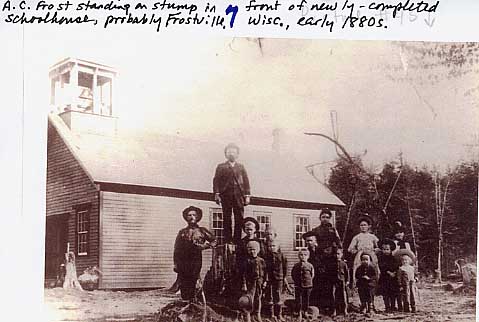
"A.C. Frost standing on stump in front of newly completed schoolhouse, probably Frostville, Wisc., early 1880's." Photo - Dewina Frost Branch - Chris Pacetti Collection courtesy of Broward County Historical Commission - Florida **** "The first Frostville School, originally a small log cabin, was built in 1878. Later wooden siding was put on the building. It was replaced by the present brick school that still stands today. Miss Annie Volk of Oconto Falls was the first teacher, followed by Nellie Bellew." written by Oconto County Historian B. Paulson - 1971 and posted with his permission. Published in the Oconto County Reporter |

Behind the school is the Hotel built by A.C. Frost and run by his brother-in-law Mr. Gregerson. c:1900. B. Paulson Collection |
Always looking for business opportunities, Frost also became a cutter and hauler of logs. From the profits of this venture, he built a hotel, a blacksmith and wagon building shop, a store building, and a large private home. This settlement was officially named "Frostville." His Danish neighbors supported his community efforts by appointing him a member of the Town(ship) Board, Secretary of the School Board and elected him Justice of the Peace.
Being the Justice of the Peace had greater
obligations then. Frost was an elected judge in small civil and sometime
criminal local township court. Because he knew almost everyone and everything,
it just came naturally.
Oconto County Reporter
Dec. 19, 1885
Mr. Gust BOTY had MESSERSMITH arrested for stealing a stack of marsh hay containing 320 pounds. They accordingly proceeded to Mr. A.C. FROST, Justice of the Peace in Frostville, to have the matter settled. The legal manipulators were Sir J.M. ARMSTRONG on behalf on Mr. BOTY and the invincible Hon. JOSIE C. ARMSTRONG appeared on behalf of MESSERSMITH. After sifting the evidence to his (FROST'S) satisfaction he dismissed the case. The town to pay the costs. Mr. BOTY's attorney intends to appeal the case to the Supreme Court.
He married couples, and he was often first
to meet settlers. Where did the newcomers go for help and advice?
The local store keeper, postmaster and Justice of the Peace, of course.
Frost knew a great deal about the individuals and families. So with carefully
planned ventures, his early income was derived from the homestead farm,
lumbering/logging contracts with large milling companies, Postmaster's
pay, Justice of the Peace pay, General store income, and rental income
from buildings and property he owned.
Oconto County Reporter
Dec. 11, 1891
Sever Anderson and A. C. Frost have taken a contract from the Holt
Lumber Co. to put in 2,000,000 ft. of pine on the Waupee river. They have
already commenced operations and have 2,000 logs on skids.
Early "colonizers" had to work very hard the first years as pioneer settlers to build up this situation, but it often paid off nicely. A.C. also had lots of capable children to help build and maintain his interests, and that was priceless. It freed him to continue searching for new developments to create and invest in. He was smart, and he was also lucky with his family's strong work to support his many continuing ventures.
Losing His Wife
Seven years after his marriage to
Mary
Gregerson, his wife died, leaving him with 4 small children. The
Oconto County Reporter printed the following reports:
Oconto County Reporter
September 19, 1885
Frost – Died at her residence in the town of Maple Valley, Friday, September 11th, 1885, in the thirty-third year of her age, Mary A. the beloved wife of Mr. A. C. Frost.
The deceased was a good neighbor, an affectionate wife and devoted mother. By her death four children, the eldest seven years of age and the youngest but eighteen days old are deprived of a mothers love and care. Her funeral services were held Monday forenoon, at the schoolhouse near her home, and were conducted by the Rev. S. H. Couch and H. Berg, the first mentioned in the English language and the latter in the Scandinavian. The funeral was largely attended and a great concourse of her neighbors, friends, acquaintances and relatives followed her remains to their last resting place in the “silent city”. Mr. Frost has the sympathy of all in his bereavement.
Second Bride and Trip to Denmark
First
there were other pressing personal needs to attend to and he had a family
to regather and support. The Pre-1907 Wisconsin State Marriage Index lists
the following:
Marriages
A C Frost 21 Mar 1886 Oconto County
Mary L P Hanson 21 Mar 1886 Oconto County
The newspapers printed the following happy
news:
Oconto County Reporter
April 3, 1886
We have the pleasure of recording the marriage of our eminent townsmen,
Mr. A. C. Frost, on Sunday last. The bride, Miss Mary Hansen is a very
estimable young lady, and a resident of this town (Maple Valley). The affair
took place at the residence of the groom, the Rev. Mr. Couch tying the
knot. We wish them success and much happiness in their new relation.
Returned To Changes In Frostville
Prospects
in the "old country" had not improved and could not begin to compare
with the opportunities of his new home. After 6 months Frost stated that
he returned to find that many of his Danish neighbors were in the process
of moving west, leaving the small settlement of Frostville. Those moving
in were strangers, and Frost found himself with greatly diminished authority.
Oconto County Reporter
April 3, 1886
Henry Johnson has sold his farm and blacksmith shop to Phillip Bitters
of your city, (Frostville), and will soon move away to Dakota (Territory,
not yet a state). Christian Fredrickson has also caught the fever, and
will soon make a home on the boundless praries.
It
was time for Frost to again focus on new developments. The county paper
ran the following report just 5 months later:
Oconto County Reporter
Sept. 25, 1886
Maple Valley
A. C. Frost is contemplating a visit to the old country soon, to solicit the emigration of his countrymen to this town.
North to Mountain
Frost moved north from his namesake settlement, to again put his total efforts into the logging business. At that time he also applied for another post office and became the postmaster. This settlement was officially named "Mountain" after the large rock outcropping on which it was originally built. Ever expanding his efforts, several mail routes were then organized, which he subsidized and within the year he had organized the town(ship) of Armstrong (now named town of Mountain). He served as chairman of the Board of County Commissioners of Oconto County and was again elected Justice of the Peace. His new wife presented him with a daughter named Charlotte in July of 1887, who was named for her grandmother Charlotte Hansen.
Loses Second Wife Suddenly
There
were now 5 children in the Frost household. While washing family clothes,
wife Mary was suddenly stricken and died. It was determined that she had
succumbed to a heart attack.
Wisconsin Deaths, 1820-1907 :
Mary Frost 09 Oct 1888 Oconto County
With five young children and several businesses
to manage, having a dependable wife was an absolute necessity. Catherine
Johnson was a local German woman who accepted the marriage and the challenges
it brought.
Marriages
Andrew C Frost 13 Dec 1888 Oconto County
Catharine Johnson 13 Dec 1888
Wisconsin Republican With An Agenda
Frost was a diehard Republican while in Wisconsin, but he deeply resented the powerful hold some Republican Party senators had over state affairs, especially the logging industry. Reformist Congressman Robert M. LaFollette had his support and friendship in the effort to fight special interests. In 1895 Oconto County electors sent Frost to the Wisconsin State Legislature where he fought with some success, for the rights of the individual against special interest groups.
During this time, the Frost family had added Sheridan, Mamie and Sherman in 1890, 1891 and 1892. That brought a total of eight children by his three marriages. The family generally managed and maintained all the Frost concerns during his sometimes long absences.
Frost, like many, got into trouble when he
was tied down in one place too long. In his memoirs,
W.A. Holt of the prominent lumbering family writes the following about
his contemporary:
" Perhaps the ablest of the early
settlers was A. C. Frost, who located first at Maple Valley and afterwards
at Mountain, where he was the king of that territory for some years. One
of his principal objects in life was to collect all of the taxes he could
to be spent in his Town, and we had a good many controversies with him
about that."
Mr. Holt further related that on one occasion
when the company was late with paying their taxes to him, Frost took a
deputy sheriff to one of the camps and stopped all the work being done.
He locked the horses in the barn and posted a guard there for two or three
days until taxes were settled.
Restless, with an overabundance of energy,
and a strong need to control, Frost got into things that were not his strong
suits; often leading to the making of poor choices that cost loyal friends
and financial supporters. Relationships were not easy for him. That required
patience, which was in short supply. His sons had the patience to handle
day to day "people things". After all, they were raised with him and learned
first hand how to deal with those who could be impatient and difficult.
Passion for starting business interests was his calling card; Frost's personal
answer to adventure.
Oconto County Reporter
September 22, 1894
A.C. Frost, postmaster of Mountain since the post office was first
established there by the government, has resigned and recommended his successor,
H. M. Baldwin, a good democrat and proprietor of a general store.
Election to the Wisconsin State Legislature Leads to Bigger Things
Florida First Beckons
Once the legislature adjourned in 1895, railroad speculators and owners, prominent men of their time, invited Frost to begin communities along the railroad route of the Tallahassee, Georgia and Carrabelle Railway. The line went from Tallahassee, Florida, to the Gulf of Mexico, and the railroad owned considerable land along the route. Florida was a tropical wilderness frontier at the turn of the century. It was the custom of railroads to colonize along their routes, which increased ridership, the transportation of produce and products, and added greatly to profits. The land along the route was studded with vast marsh, wetlands and swamps which needed draining. The homesteading life was hard and needed a leader who could keep people going when things were difficult. A. C. Frost had proven his skills in this arena.
In Tallahassee, Frost was welcomed to the Florida Legislature with open arms, extending him the courtesy of both houses. What he saw was not to his liking, however, and Frost returned to Wisconsin to plunge into large scale sheep raising with E. H. Gilkey.
National Business Activities
Begin In Springfield -
Three Major Investment in 1897
Not to be confined long, Frost journeyed back to his earlier place of residence, Springfield, Illinois, with other Wisconsin legislators in 1897. He had left Springfield as a fledgling itinerant traveling salesman in a horse drawn wagon in 1874 and had returned 23 years later as a prominent businessman.
Always on the lookout for new investments, he became interested in the idea of an electric rail line that would run between Milwaukee and Chicago. The Bluff City Electric Railway had started this project in 1892 but due to financial problems and was absorbed in 1897 by the newly created Chicago and Milwaukee Electric Railway Company. A.C. Frost became president of the Chicago & Milwaukee Electric Railroad in 1897. On documents he listed Chicago as his home residence. Bonds were sold for investment in this new company.
Becomes President of the Alaska Northern Railway
It was also on this 1897 visit to Springfield that A.C. Frost was approached by railroad men from Alaska, interested in his involvement toward building the Alaska Northern Railway. He is recorded as being president of the company already in 1897 and 1898, with another investor, banker H.C. Osborne of Toronto, as vice president. Members of the board were replaced by employees and friends of Frost and Osborne. A look at the names of people working in Alaska for the Frost company in those years reveals many former Oconto County residents. Whole Oconto County families had apparently sold out and moved there in anticipation of lucrative and lengthy employment in this ill fated venture. But for the present, the rail line was growing from the solid and lucrative start it had with previous owners. It was a venture heavily invested in by banks and individuals who bought bonds in the company to the tune of several million dollars.
Becomes Land Agent for Florida Railroad Development Company
During this same 1897 trip to Springfield, Frost was also introduced to James E. Ingraham, who was originally from Green Bay, Wisconsin. Mr. Ingraham was now Vice-President of the Florida East Coast Railway, in charge of land sales subsidiaries and was seeking settlers and land agents to increase population and production along the railway. Frost wrote that by this time he had quite a reputation "as a colonizer in Wisconsin." Carried into the adventure by Mr. Ingraham, Frost decided to colonize east south Florida.
Leaves Wisconsin
One important factor in what looked to be sudden business decisions to leave Wisconsin, was that originally the railroad in Oconto County was to be extended to Mountain, Forstville and Hayes, bustling new villages. The railroad had purchased the land for the route several years before the actual work had started, so Frost and other businessmen based their choice of land purchase locations to take advantage of the railroad for commercial advantages. In 1896, after Frost had invested and established his parcels and had purchased more land nearby to sell, the railroad deemed that area too "soft" (swampy) for railroad construction. The depot and line was constructed on higher land some distance away from where Frost owned his properties. The value was lost as the community center gradually began moving toward the depot. This also happened in Lena. In Frostville and Hayes the rail bed was moved east to a swampy little place later named Suring, because land had been donated to the railroad for the depot by a local developer. This spelled the gradual end of these villages being able to compete for population and business without the railroad service.
Florida Living Begins For The Frost Family - 1900 to 1905
Frost returned to Oconto County from his trip to Springfield, Illinois; sold his sheep ranch to his partner. He packed up his wife and children, which by now also included additional son Sherman, born in May 1898, and daughter Dewina, born Jan 1899, according to the 1900 Federal Oconto County Census. The family headed for Miami, Florida in the winter of 1900, where he became a Model Land Company agent to the town of Modello and settled in a prefabricated home there in 1901. Besides the Frost family, the new community had two married couples and three bachelors as residents. Oldest son Gregors, now an attorney who had graduated from the Northern Illinois College of Law at Dixon, did not join in that move, instead settling in Titusville where he became Mayor. In later years Gregors would also move to Dania.
Living was primitive there at best. Frost was expected to create an environment described in Model Land Company advertisements as "a beautiful town site located on both sides of the river (New), with a road passing through the center of it. Trains daily. Has one store, hotel, post office, etc. An excellent place to locate in. Rich fruit and trucking lands all around it, and promises to settle up rapidly the coming year. Lots $50 to $250." In 1900 the thirty miles of coast along South Florida had fewer than 200 residents. The "cities" to the north had between 10 an 25 residents each and the metropolis of Fort Lauderdale had and estimated 125. Frost was 55 years old and he had 10 children, five of which were still very young. Frost was by far the oldest of the area's settler leaders. New families and individuals soon joined the community, some arriving by covered wagon in 1902. Frost developed a small tomato farm in the East Marsh near what is now the Intracoastal Waterway and headed north in 1904 to colonize Modello, Florida.
In 1902 the Frost family had moved into a new larger house and constructed a general store. Frost was made the first appointed postmaster, providing service from his store.
Traveling north to Oconto County, he returned to Modello with 30 adults Danes later in 1904. The newcomers primarily started small scale farming on nearby drained land which Frost was land agent for. That year, the community changed the name to "Dania" in honor of the Danish heritage of many of the residents and was incorporated. There was no jail and the first prisoner was tied to a tree by Marshal Hart, but slipped away shortly afterward. John W. Mullikin was first mayor and Frost became president of the first city council.
Although he seemed quite successful in his own ventures, more and more Dania area residents turned to him for financial assistance and advice especially during the many community get togethers. They were struggling with a very primitive environment they had not expected. Many of the Danes he had recruited became disheartened by the snakes, wild animals, dangerous marshes, mosquitoes carrying malaria, as well as the almost total lack of meat and milk. There were outbreaks of Typhoid Fever, which killed many. Even with the great effort of Frost to extend credit in his own store for groceries, special land term payments to him and other encouragements, many of the Danes and others left northward.
Dania did continue to grow despite these setbacks.
Following the Florida Coastal Railway Company dredging of a canal from
the Atlantic Ocean to the center of Dania. Frost invested in land north
of Dania as it carried a higher potential for future settlement.
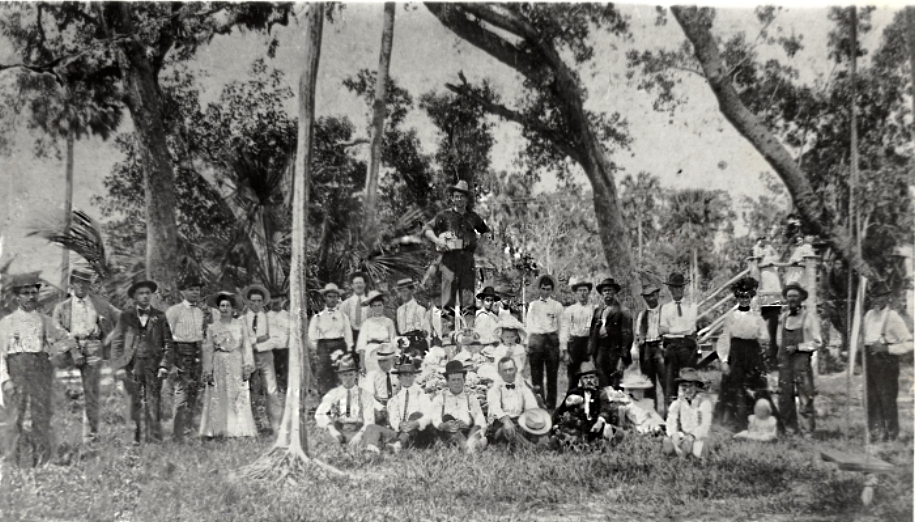
Sunday Social Gathering - 1905 Dania at the Hinkley homestead. A.C. Frost is seated sixth from left in the front row. He is in a dark suit with a hat and has a grandchild on his lap. Children seated to the right of him are his own youngest. courtesy of Broward County Historical Commission Eby Collection - Florida |
Like many others before him and since, A.C. Frost achieved success and financial stability using the skills and experiences he had developed from hard work as a young man. Frost was a proven developer and colonizer of land. He had done so in Frostville and Mountain, Wisconsin. But the temptation to go beyond into "uncharted waters" was great. There were always businessmen, honest and otherwise, calling on the successful to participate in new projects. Promoters were quick to sense that offering an impressive title, such as Company President, was a very attractive lure.
Developments In Illinois Also Took Much Of His Time - 1897 to 1907
While his Florida holdings were being developed, Frost also spent considerable amounts of time in Illinois overseeing his Electric Railroad expansion. At the same time his family was settling in Florida, Frost listed his home residence officially as Chicago, Illinois. The Chicago and Milwaukee Electric made many changes and greatly expanded the small electric line by ordering new, more comfortable cars and and increased the line well north of the city toward Milwaukee. At first the name was more of a prediction than a reality, since the line only ran from south of Chicago to the north side of town originally. In order to increase ridership on the rural stretches north of Chicago, A.C. Frost established and began building Ravinia Park, May 12, 1898. It was to be a tourist destination.
Construction costs were steep on both the Illinois electric railroad and entertainment park projects from the time of Frost's takeover in 1897. Progress was slow on both projects with much waste of money, labor and time due to inexperience, poor management descisions and inattention to details. The Ravinia Park was advertised as "the superior amusement park'' on 36 farm acres running on either side of his railroad's tracks just south of Highland Park. When Frost had the Grand Opening of Ravinia Park on Aug. 15, 1904, he was on his way north seeking buyers for the Florida property. Frost presented his Illinois electric railroad passengers with a grand new theater having its own pipe organ, a pavilion with rooms for dining and dancing, a multicolored electric fountain and a baseball diamond. Frost was sure Chicagoans looking for a relief from the crowded city would come.
The number of visitors to his Ravinia Park, in Illinois, was not enough, year round, to keep the company going. Frost refused shareholders requests to step down as President and by 1907 the railroad and park were the subject of Federal Court sessions for involuntary bankruptsy. By 1910 both his railroad and amusement park were in receivership in debt for $5,000,000 according to court records. This was one venture Frost did not relate in his biographical sketch. Both were bought out by others and survived to succeed. The electric railroad line, called the "Hinky Dink" in Milwaukee because of the sound the wheels made on the tracks, ran to Chicago until the mid 1900's. The amusement park "Ravinia" recently celebrated it's centennial and is still providing entertainment.
His time in Florida and Illinois was also shared with considerable time spent in Seattle, Washington. In 1897 A.C. Frost had also became President of the Alaska Central -- Alaska Northern Railway. Both the Illinois and Alaska railroad ventures had been started and were in service at the beginning of Frost's involvements. Both ventures also were in the process of further expansion and were using considerable public and bank invested funds from both the US and Canada.
Frost and his business partner, banker Osborne
of Canada also owned all the stock in the solidly established Tanana Railway
Construction Company which was under contract to build the Alaska railroad.
They knew almost nothing of the skills, continuous scrutiny, budgeting
and management needed for running and expanding a major railroad. They
knew little about construction of rail lines and of running such a building
company. Frost also again surrounded himself with company board members,
management and employees who were known to him, but had no skills or experience
in theses venues.
Oconto County Reporter
18 February 1898
James Sargent and John Slattery left on Wednesday for Seattle, where they will make final preparations for their journey to Alaska.
Constuction work on the Alaska railroad had been virtually abandoned by October of 1907; mortgage bond interest was in default. Many of the people who had been recruited in Oconto County and had moved as individuals and families to Alaska, with the promise of lucrative employment, were unpaid as early as 1898 according to court records. Vast amounts of expensive new equipment and materials had been stolen, sold by employees, or abandoned and were no longer usable. Again, Frost had repeatedly refused to step down as President of the railroad and construction companies, or to permit a meeting of the legal shareholders for the election of a new set of officers; certain that he could work out the difficulties on his own. The Alaska road was nearly $8,000,000 in debt. By 1908 Frost was totally unable to accomplish funding of the Alaska projects because of his Chicago dealings as well as not having the time, credit level or contacts to make an effort to otherwise finance the businesses.
A letter publish in the newspapers written by stockholder John E. Ballaine in Seattle, Washington, March 31, 1911 gives his take on the condition of the Alaska railroad project as it evolved from the purchase by Frost and Osborn. Mr. Ballaine had filed a petition for a receiver in May of 1908 for the failing Alaska Central Railway company, only to find by that year, Frost was in deep financial trouble in Chicago. Frost was individually in the hands of a receiver appointed by the US Court there and all the corporations formerly controlled by him in Wisconsin and Illinois were now in the hands of receivers. Judgments of thousands of dollars had been made against him there and he was in involuntary bankruptcy. He had refused to step down as President of the failing electric railroad company until removed by law, was $17,000,000 in debt and all his Wisconsin and Illinois assets were tied up in court.
To compound his problems, Frost had lost significant additional personal funds in a 1904 swindle perpetrated by a former employee. It involved Frost's, and many others', investment of large sums of money in an Alaska coal mining property and development scheme. Coal was needed in the running of the steam engines used to move trains and power other equipment that railroad construction used. Having it's own ready source and supply of local coal was an intelligent business move. Frost's and other investors' monies were never used on the development of the Matauska district coal mining project and disappeared.
According to the John E. Ballaine account, Frost's swindler had also passed himself off, for a time, as appointed by railroad President A.C. Frost to function as general manager in his absence. He wasted no time moving into the general manager's role and office in Alaska. He had made illegal contacts with individuals and companies in the name of the railroad and received considerable "kickbacks" before being exposed. He was not prosecuted by Frost, it was learned later, because he threatened Frost with "exposure" as being at the root of the mining swindle and all his locations to the danger of cancellation. Frost was a victim as much as any other investor in the swindle, but his other financial problems made him afraid that he would be blamed as a perpetrator. Frost was removed from the Alaska railroad and construction companies by involuntary bankruptcy during US Court proceedings held 1911 in Seattle. The court proceedings ended in 1914.
Little Told Of Those Years
In his autobiographical sketch, from 1907 to
1914 Frost claimed to have caught the travel bug which began with a six
month tour of Europe accompanied by his son Gregors. Returning for only
a short while, he wrote that he went on to spend several months in
Mexico and California, ending this trip with a visit to an exposition in
Seattle, Washington in 1911. Frost made no mention of his considerable
time spent, during those years, in Illinois and US dealing with the
railroad involvements and court hearings. It is not known if he actually
visited Europe, Mexico or California. He said that he found no opportunities
that appealed to him in these journeys and returned to Dania with the idea
to establish the Bank of Dania which opened in 1912.
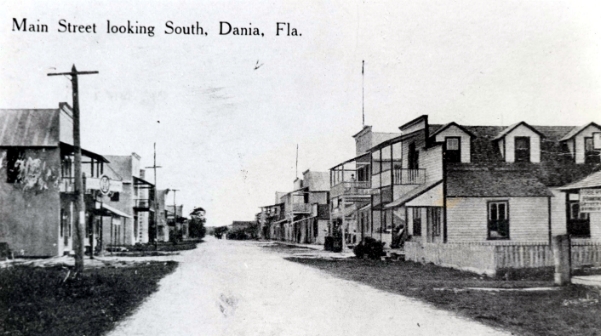
Main Street Dania, Florida - 1912 courtesy of Broward County Historical Commission Eby Collection - Florida |
Back to Oconto County, Wisconsin
However, Frost, at age 64, had left Dania
in 1911 for Oconto County, Wisconsin hoping to restore his health from
illness he was said to suffer. He was welcomed back by old friends and
elected to the chairmanship of the Town Council of Oconto for two terms.
He also served on Oconto County's Board of County Commissioners for
a term and helped organize the Farmers Bank of Oconto. He purchased property
and operated several successful businesses on them. Once his health was
restored, and the bankruptsy court hearing were finished, he liquidated
his Oconto County investments in 1914 and returned to Dania, where a whole
new set of careers awaited him.
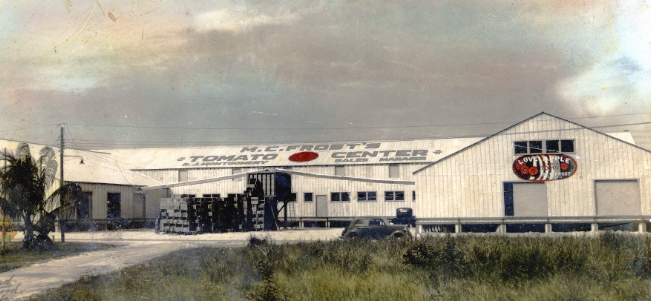
M. C. Frost Tomato Sales Packing House - Built in 1910 Florida's "Love Apple" (advertising slogan on building to the right). Photo taken 1930's. Martin Frost, son of A.C. Frost, led the family in the development of his father's Florida investments during long absences in the early 1900's. courtesy of Broward County Historical Commission Clark collection - Florida |
While absent much of the time between 1907
and 1914, Frost had retained ownership of all his property and interests
in Dania. Son Martin C. Frost led his other sons in the continued development
of their father's holdings. To add to this activity, Frost himself initiated
several smaller development schemes during short visits to Dania. The purchase
and development of land was a gold mine for the family. Frost was back
in time to put in the 1914 - 1915 winter tomato crop and the opening of
the modern Dixie National Highway through Dania. It was the first paved
road constructed along Florida's east coast and direct route from Chicago
to Miami. An independent Broward County was formed with his assistance
and support, more canals were built and lands drained for sales by agents
and developers to crop farming buyers. State highways, Democratic office
candidates and building a tomato factory were projects that enjoyed Frost's
energies.
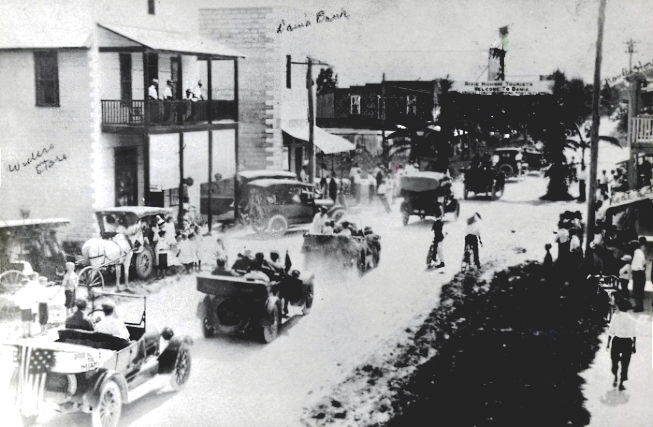
Dania 1915 - Dixie National Highway Opening Celebration. Chicago to Miami. The general store is the first building on the left, the next brick building is the Bank of Dania which A.C. Frost helped to establish, it opened in 1912. Here on October 24, the first car convoy on the highway to come from Chicago are seen entering Dania, completing the trip in 13 days. There was much cause for the "wildest excitement". The Frost holdings in Dania greatly increased in value with this opening. There were approximately 15 cars owned in Dania at the time, Frost owned one of them. courtesy of Broward County Historical Commission DDS collection - Florida |
Still, being in one place for any length of
time seemed to bring a considerable degree of conflict to Frost's environment.
He was a man of sometimes rigid beliefs and not likely to keep them to
himself. He lead an anti Catholic movement that cost people their jobs
and homes. There was his need to support the Model Land Company in charges
they had not paid their drainage taxes. Frost now wanted former very close
friend Senator La Follett of Wisconsin banished from serving in the Federal
Senate for his opposition to World War I and branded him a disloyal to
his country, as well as applauded at the tarring a feathering of R. C.
Laycock after he spoke opposing America's involvement in the war in the
neighboring village of Davies.
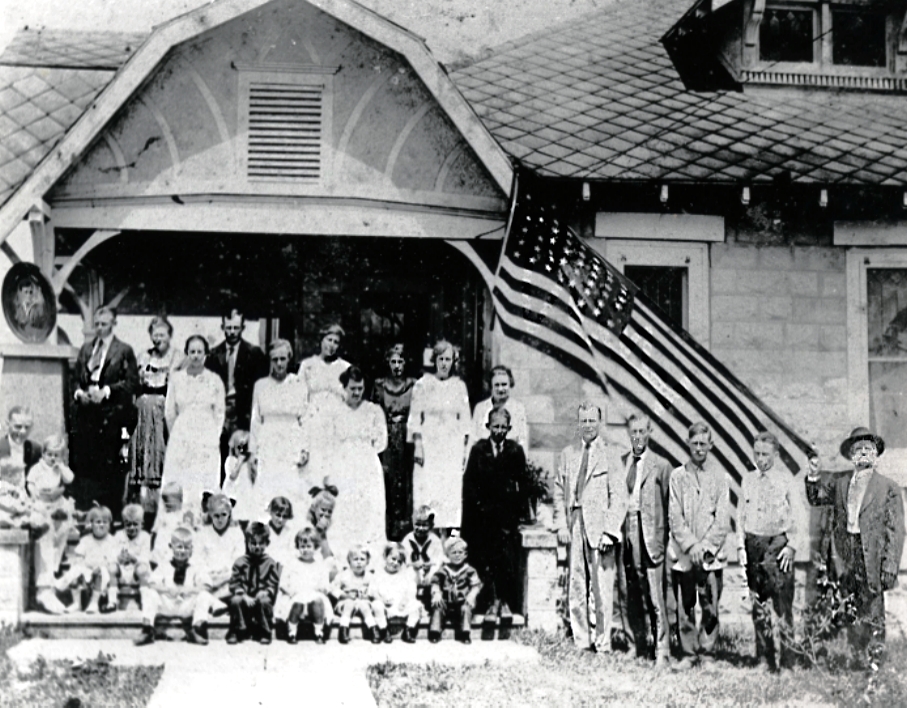
Three generations of the Frost family in 1918. Three marriages and 10 children born in Oconto County, Wisconsin The US was participating in World War I when all the children and grandchildren posed for this patriotic photograph at the Dania Frost home with A.C. Frost (standing at far right holding the flag corner) and his third wife Catherine Johnson Frost. Catherine was the mother of the youngest 5 Frost children. The photograph in the oval frame on the left side of the porch is of son Sherman, who was serving in the US Navy. A. C. Frost's first wife was mother of his first 4 children, Mary Gregerson Frost. His second wife was Mary Hanson, with whom he had one daughter, Charlotte. His first and second wives died at young ages. Children of A.C. Frost in order of age were Gregor, Anthony, Mattie, Martin, Charlotte, Sheridon, Mamie, Sherman, Lincoln, Dewina. courtesy of Broward County Historical Commission Eby Collection - Florida |
Frost had indicated his extremely pro-American patriotism earlier by naming his last group of children after past prominent Americans; Sherman, Sheridan (military generals), Lincoln, Mamie and Dewina, the youngest after Admiral George Dewey. Frost was anti European government just as strongly. The Milwaukee Sentinel printed his letter to them on February 1, 1918 in which he described at great length how German sympathizers in a New Jersey food company that had tried to poison American loggers in Oconto County, Wisconsin and put ground glass in the peanut butter jars it sold in Dania. He went on to support the execution of anyone not supporting the American War effort. in late 1918 and early 1919 Frost engaged in a lengthy, fierce public struggle with former long time friend and financial supporter, Banker M. C. Hardee about donations going toward hastening "bringing the boys home" requested by President Wilson of private organizations.
After serving on the Broward County Board of Commissioners in 1921, Frost was said to have left for Maryland, without explanation, during the great Florida Land Boom. It may have had something to do with one remaining long time friend's recent move to Chesterton, Maryland, Commissioner A.B. Lowe. The following three years in Maryland have no clear description. He was said to have founded the town of Frostburg in the western portion of that state, however, according to the US Census Renumerations, that sizable city was named and established long before A.C. Frost came to America.
Frost was again reported as being quite ill
those final years. It is known that he spent considerable time during those
three years in Oconto County, Wisconsin. Again, in his memoirs,
W.A. Holt of the prominent lumbering family, writes the following about
his contemporary:
"He returned several times to visit in Mountain, and he came into my
office (in city of Oconto)and visited
with me. He invited me to come to Dania to see him and his son when I was
in Florida, but he said there was one thing he wanted me to promise him
and that was never to say to any one in Florida that he had been a Republican
member of the Wisconsin Legislature. He said his son had to be a Democrat
in order to get anywhere in Florida, and had been elected Mayor on the
Democratic ticket, and of course A. C. Frost had to be a good Democrat
too as his friends would have been very much provoked with him if they
had learned that he had been a Republican in Wisconsin."
Frost died in Dania in 1924. He is buried in
Woodlawn Cemetery.
~~~~~~~~~~~~~~~~~~~~~~~~~~~~~~~~~~~~~~~~~~~~~~~~~~~~~~~~~~~~~~
Resources used:
Broward County Historical Commission Eby Collection
Broward County Historical Commission Frost-Clark
collection
Summer/Fall 1979 Broward Legacy article on
"Dania - A.C. Frost Founding Father"
Oconto County, Wisconsin - Plat and Altas
Maps
Oconto County, Wisconsin - Federal Census
Renumerations
Broward County, Florida - Federal Census
Renumerations
US Federal Court Records
The Oconto County Reporter - Newspaper
Seattle Times - Newsapaper
Memoirs of
W.A. Holt
John E. Ballaine - Published Newspaper Letter
"Alaska Central - Alaska Northern Railway" March 31, 1911
History of the Danish Brotherhood in America
Centennial of Ravinia Park, Highland Illinois
- pamphlet
History of the Chicago and Milwaukee Electric
Railroad
The History of Alaska Railroads
BACK TO
THE OCONTO COUNTY HOME PAGE